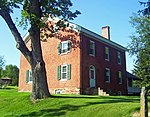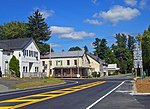John A. Lafevre House and School
Defunct schools in New York (state)Former school buildings in the United StatesGardiner, New YorkHistoric American Buildings Survey in New York (state)Houses completed in 1872 ... and 4 more
Houses in Ulster County, New YorkHouses on the National Register of Historic Places in New York (state)National Register of Historic Places in Ulster County, New YorkSchool buildings completed in 1835

The John A. Lafevre House and School is located along NY 208 in the town of Gardiner, New York, United States. It is often believed to be in New Paltz as it is within that town's ZIP Code. The house is a stone structure dating to 1772; the school was built in 1835 and remained in use for almost a century. Both are well-preserved examples of their type of building and were listed on the National Register of Historic Places in 1989.
Excerpt from the Wikipedia article John A. Lafevre House and School (License: CC BY-SA 3.0, Authors, Images).John A. Lafevre House and School
Route 208,
Geographical coordinates (GPS) Address Nearby Places Show on map
Geographical coordinates (GPS)
| Latitude | Longitude |
|---|---|
| N 41.69576 ° | E -74.12166 ° |
Address
Route 208 401
12561
New York, United States
Open on Google Maps









